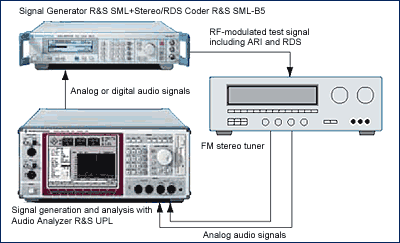| Reference Oscillator OCXO
(R&S SML-B1)
This option provides highly accurate reference frequency with a very low aging rate. |
| Pulse Modulator (R&S SML-B3)
This option provides a high-quality Pulse Modulation, featuring an on/off ratio better than 80 dB and a rise/fall time shorter than 20 ns. The pulse modulator option allows pulsed signals to be produced independent of an external source, because an internal pulse generator is included. But surely also external generated pulses can be used for the pulse modulator. |
| Stereo/RDS Coder (SML-B5)
This option opens a new application field for the generators of the R&S SML family. FM stereo multiplex (MPX) signals can be generated with an analog or digital feed in audio signal - according to the requests of the setup. Beside the stereo MPX signal, also the radio traffic service ARI (Automotive Radio Information) and Radio Data System (RDS), which are established in many countries, are supported by the option. Typical Setup with the R&S SML with the Option Stereo/RDS Coder in connection with the Audio Analyzer UPL
¡@ |
| RF and AF Rear Connectors
(R&S SML-B19)
With this option the RF and AF connectors are moved to the rear side of the instrument. |
| Characteristics Audio Analyzer UPL performs practically all types of analog measurement, from frequency response measurements through to externally controlled sweeps with reference traces, determination of 3rd-order difference frequency distortion, spectral display of de-modulated wow and flutter signals, etc. In contrast to many other audio analyzers, UPL is capable of perform-ing real dual-channel measurements in the audio-frequency range, ie there is no need for switchover between two inputs and this facility is not limited to a few special cases. The generator is every bit as versatile: it supplies any conceivable signal from sinewave and noise signals through to multi-sinewave signals comprising up to 7400 frequencies. In addition to all this, UPL features ex-cellent technical data: analog sine-wave generation with harmonics of typ. -120 dB, spectrum displays with a noise floor below -140 dB for analog and -160 dB for digital interfaces, FFT with a maximum frequency resolution of 0.05 Hz, etc. UPL provides signal
monitoring via loud-speaker during the test, jitter measure-ments on
digital audio signals, resyn-chronization of jittered digital audio
signals by means of a jitter-free clock signal, and many more features. Superior analysis concept UPL performs all measurements using digital signal processing. Analog sig-nals to be tested undergo elaborate pre-processing before they are digitized and measured by means of digital rou-tines. For example, in THD measure-ments, the fundamental wave is attenu-ated by means of a notch filter and the residual signal amplified by 30 dB before it is digitized. In this way, the dynamic range can be extended beyond that offered by the internal 20-bit converter. This provides the scope required for measuring future convert-ers, which will be technically more ad-vanced than present-day devices (see graph on the right). This concept guar-antees a performance and flexibility by far superior to instruments providing purely analog or digital measurements. The above measurement concept offers many more advantages over merely an-alog concepts: The test routines
performed on ana-log and digital interfaces are iden-tical. This allows,
for instance, the direct comparison of IMD measure-ments made ahead of
and after a converter. A future-proof investment Nobody can accurately predict today what effects future developments in dig-ital technology will have on the audio world and what will be the resulting test requirements. This is however no prob-lem for Audio Analyzer UPL. Since all test functions are implemented digitally, UPL can be adapted to changing re-quirements by simply loading the neces-sary software ¡V and this also for the an-alog interfaces. And one more thing:
Rohde & Schwarz is the only manufacturer to equip its audio
analyzers with 32-bit float-ing-point signal processors throughout, thus
offering plenty of reserves beyond the limits of today's common 24-bit
tech-nology. The name of Rohde & Schwarz stands for excellent quality ¡V thousands of audio analyzers have proven records at satisfied customers and have been in operation successfully for many years. After the purely analog UPA and UPD, which still holds the top position in today's audio measurement technology, Audio Analyzer UPL has been devel-oped to complete the program. As a competent partner we shall be pleased to advise you on the optimum use of our instruments. Our representa-tives are available for you all over the world, and our customer support center and application engineers in Munich are there to help you find the right solu-tion to your measurement tasks. In addi-tion, you will find a wealth of proposals and solutions in our application notes and software. Naturally, Rohde & Schwarz instru-ments are certified in compliance with ISO 9001. |
